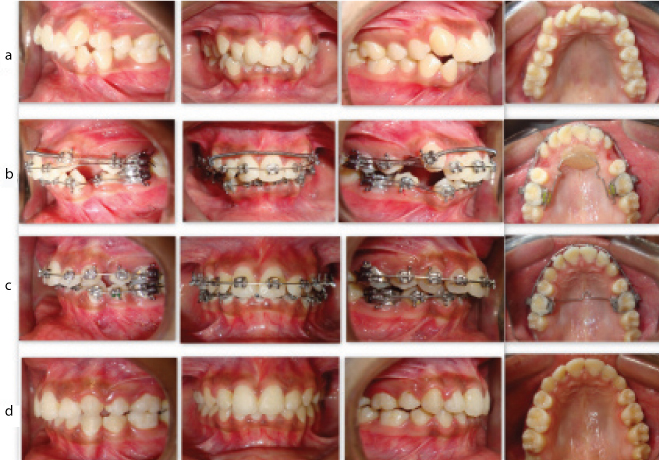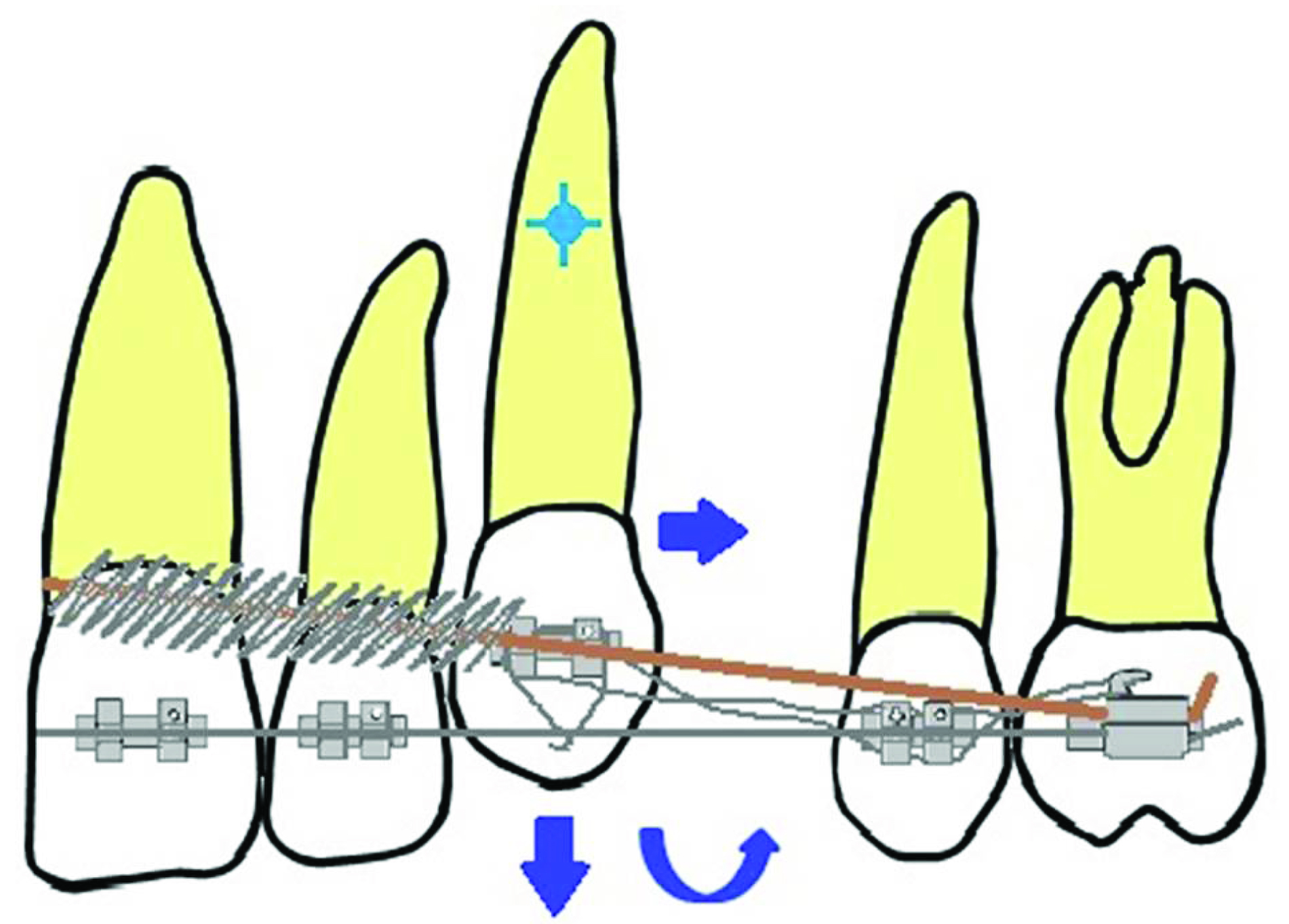A Speedy Yet Simple Tip to Align Imbricated Anterior Teeth
Bhuwan Saklecha1, Pawankumar Dnyandeo Tekale2, Shivprasad V Sonawane3, Pratik Rajesh Shah4, Harshal Ashok Patil5
1 Reader, Department of Orthodontics, Index Institute of Dental Sciences, Indore, Madhya Pradesh, India.
2 Senior Lecturer, Department of Orthodontics, Dr Rajesh Ramdasji Kambe Dental College and Hospital, Akola, Maharashtra, India.
3 Senior Lecturer, Department of Orthodontics, BVDU Dental College and Hospital, Navi Mumbai, Maharashtra, India.
4 Private Orthodontic Practice, Mumbai, Maharashtra, India.
5 Private Orthodontic Practice, Aditya Chambers, Housing Society, Jalgaon Maharashtra, India.
NAME, ADDRESS, E-MAIL ID OF THE CORRESPONDING AUTHOR: Dr. Pawankumar Dnyandeo Tekale, Senior Lecturer, Department of Orthodontics, Dr Rajesh Ramdasji Kambe Dental College and Hospital, Akola, Maharashtra, India.
E-mail: pawan0804@gmail.com
Correction of dental crowding can be achieved with several orthodontic procedures like extraction of teeth, proximal stripping etc. In contemporary orthodontic practice, resolution of incisor crowding is most commonly achieved by the use of canine lacebacks. This method takes time, requires frequent activations and taxes anchorage since it involves the “PULL” mechanics. In order to overcome these disadvantages, mostly the time factor, we devised a method of using open coil NiTi spring on 0.016” SS wire piggy backed on the 0.014” heat activated NiTi base arch wire ligated only at the canines. This method, resolved the incisor crowding in almost one third of the time taken with the use of canine lacebacks. Moreover, the result was more physiologic since light continuous force was applied with the spring and it essentially eliminated the anchorage loss since it involved “PUSH” mechanics.
Alignment,Canine lacebacks,Incisor crowding,Open coil springs,Sliding mechanics
Case Report
Crowding of teeth is the most commonly observed type of malocclusion [1]. Dental crowding is corrected using variety of orthodontic procedures like extraction of teeth, proximal stripping, arch expansion, molar distalization etc [2]. Resolution of anterior crowding requires space mesial to canines, usually requiring canine distallization. In contemporary pre-adjusted edgewise appliance, canine distallization is achieved using a “PULL MECHANICS” commonly involving the use of lacebacks [3]. This method takes time, requires frequent activations and taxes the anchorage [4]. The present article describes a method of rapid distallization of bilaterally high labially placed mesially inclined canines enabling rapid alignment of incisors using “PUSH MECHANICS” utilizing a NiTi open coil spring.
Procedure
A. Case selection:
This technique is indicated in moderate to severe anterior crowding with bilateral or unilateral mesially inclined canines which are either labially placed or present within the arch [Table/Fig-1a]
(a) Pre treatment Intraoral photographs; (b) Intraoral photographs with appliance placed; (c) Intraoral photographs after de-crowding of anterior teeth; (d) Intraoral photographs after debonding.

B. Technique:
After banding and bonding brackets and placement of passive lacebacks on the canines, an initial 0.014 HANT wire is placed with full bracket engagement except for the canines. The direct method of bonding was utilized in present case. The archwire was properly cinched to prevent incisor proclination.
The distance between the centre of the long axis of right and left canines was measured with the help of a brass wire on the patient’s pre treatment model.
An open coil NiTi spring of length measuring one third extra [5] of the measured length was cut.
This was followed by passing this open coil spring through a 0.016 SS wire which is inserted into the auxiliary slot of the molar tube [Table/Fig-1b].
Ligation of the SS wire was done on both the canine brackets with the open coil spring compressed approximately one third of its original length in between [5] [Table/Fig-1b]. The canines were also loosely attached to the base archwire for their vertical control [Table/Fig-1b].
The spring can be covered with orthodontic wax to avoid lip lacerations.
Image showing PUSH biomechanics of canine with NiTi open coil spring.

Once the canines got distalized, they were secured with a passive laceback, and the piggyback 0.016” Stainless wire was removed. They were fully engaged into the 0.014 HANT wire. With the completion of alignment the wire was replaced with a rectangular NiTi, here .019 x .025 Heat activated NiTi was used for completion of leveling. After leveling completion, .019 x .025 ss wires were placed and the space closure was carried out with sliding mechanics.
The total time taken for aligning was reduced markedly to two months in contrast to over 6-8 months if the case was aligned with the use of conventional mechanics.
Discussion
Cases with anterior crowding and high labially placed canines are commonly encountered in routine clinical practice. Such situations can be effectively managed using a NiTi open coil spring. In the case shown, the crowding got resolved and the incisors aligned by canine distallization within eight weeks [Table/Fig-1c]. The remaining extraction spaces were closed in seven months duration [Table/Fig-1d]. The patient discontinued the orthodontic treatment after correction of anterior crowding due to his personal and professional reasons. Still there was need of correction of deep bite and slight mid-line shift.
In the present case, the both right and left maxillary canine were superiorly placed and mesially inclined. Here the 0.016” SS wire was engaged only in the maxillary canines and directly secured into the auxiliary slot of the molar tube. The wire was cinched properly. Because of increased inter-bracket distance between right and left canine, the flexibility of the wire increased, hence full engagement of the stainless steel wire was possible which allowed three dimensional control over the canines. At the same time, this increased friction which meant that a slightly greater amount of force would be required to push the canines distally. Since, the line of force lied both occlusally and buccally with respect to the centre of resistance of the canines, we would expect them to be uprighted and rotated. But, this was prevented by the full engagement of 0.016” SS wire into the bracket slot. [Table/Fig-1b and 2].
The total force required was 280 grams which includes the 140-240 grams force and 40-60 grams force in addition to overcome friction. [5,6] Hence, the effective distalizing force for each canine was 140 grams. The spring was passed through the 0.016 SS wire. The SS wire was ligated at one of the canines while the other canine was kept free to keep the spring at rest position. The force applied was measured with the help of a dontrix gauge by tying a ligature to it and the spring on the side where the canine was not engaged to the 0.016” SS wire.
In this case, 0.016 SS was utilized for distalization of canine, since it is the wire that is round ss where in the walking of canine is possible with minimum of friction and in short duration of time. In contrast, the usage of rectangular wire should be avoided due to increased friction and hence the time taken would be more. [7,8].
Limitation
This technique cannot be used in the patients having buccally placed maxillary canines with shallow sulcus, as the open coil spring may lacerate the upper lip and mucosa in maxillary anterior sulcus. Another limitation is that patient cooperation is required as if in case the ligature wire securing the piggyback wire becomes loose or untied, it may lacerate upper lip.
Conclusion
The NiTi open coil spring produced favourable and predictable response because of its light continuous reciprocal “push” force eliminating the tendency of mesial movement of molars. Furthermore, this technique offers an extra advantage of reduced chair side appointments.
[1]. El-Mangoury NH, Mostafa YA, Epidemiological panorama of dental occlusion Angle Orthod 1990 60:207-14. [Google Scholar]
[2]. Howe RP, McNamara JA Jr, O’Connor KA, An examination of dental crowding and its relationship to tooth size and arch dimension Am J Orthod Dentofac Orthop 1983 83:363-73. [Google Scholar]
[3]. McLaughlin RP, Bennett JC, Anchorage control during leveling and aligning with a preadjusted appliance system J Clin Orthod 1991 25:687-96. [Google Scholar]
[4]. Sueri MY, Turk T, The effectiveness of laceback ligatures on maxillary canine retraction Angle Orthod 2006 76:1010-14. [Google Scholar]
[5]. Chaconas SJ, Caputo AA, Harvey K, Orthodontic force characteristics of open coil springs Am J Orthod Dentofac Orthop 1984 85:494-97. [Google Scholar]
[6]. Vakil KK, Tekale PD, Vakil JK, Soldered Power Arm. Easy and effective method for intrusion and retraction of anterior teeth J Ind Orthod Soc 2014 48(1):72-75. [Google Scholar]
[7]. McLaughlin RP, Bennett JC, Trevisi HJ, Systemised orthodontic treatment mechanics 2001 EdinburghMosby [Google Scholar]
[8]. Alexander RG, The alexander discipline contemporary concepts and philosophies 2008 IllinoisQuintessence [Google Scholar]